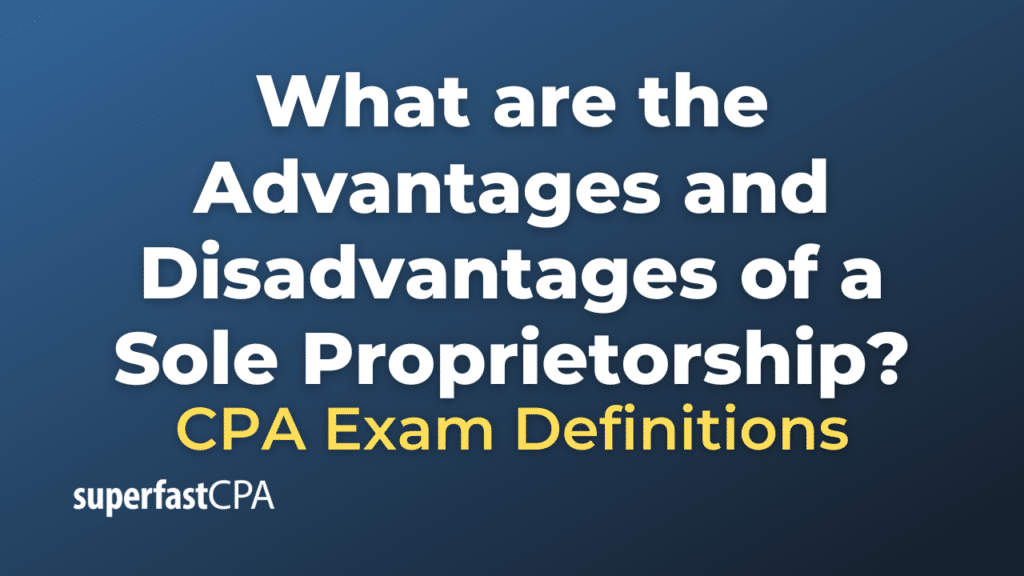Advantages and Disadvantages of a Sole Proprietorship
A sole proprietorship is one of the simplest forms of business structures. It has both advantages and disadvantages that one should consider when deciding on a business entity type.
Advantages of a Sole Proprietorship:
- Ease of Formation: Starting a sole proprietorship is straightforward. It often requires minimal paperwork and formalities. In many cases, there are no special licenses or permits needed beyond those required for the particular type of business.
- Direct Control: The sole proprietor has complete control over the business decisions and operations. They don’t need to consult with partners or shareholders.
- Simplified Taxation: Profits and losses from the business flow directly to the owner’s personal tax return. This avoids the “double taxation” that can occur with some other business structures like corporations.
- Flexibility: The owner can change business strategies or even the nature of the business itself with ease, adapting to new opportunities or market conditions quickly.
- Fewer Formalities: Sole proprietorships typically don’t have the formal meetings, reports, and other administrative requirements that corporations or partnerships might have.
- Direct Benefit: All profits of the business belong to the owner.
Disadvantages of a Sole Proprietorship:
- Unlimited Personal Liability: The owner is personally responsible for all debts and liabilities of the business. This means that creditors can go after the owner’s personal assets, like their home or car, if the business can’t pay its debts.
- Limited Financial Resources: Raising capital can be challenging since the business cannot issue stock, and financial institutions might be hesitant to lend to sole proprietorships.
- Limited Skillset: The success of the business is largely dependent on the skills and abilities of a single individual. There’s no partner to complement or supplement the proprietor’s abilities.
- Continuity Concerns: The business’s existence is tied to the owner. If the owner dies or becomes incapacitated, the future of the business can be uncertain.
- Burden of Management: All responsibilities, from decision-making to administration to hands-on work, fall on the owner.
- Potential for Higher Taxes: Depending on the amount of income and the specific tax laws, sole proprietors can sometimes end up paying more in taxes compared to other business structures, especially if the business is highly profitable.
- Difficulty in Selling or Transferring: Selling or transferring the business might be more complicated than with a corporation or partnership.
When considering a sole proprietorship, it’s essential to weigh these advantages and disadvantages against personal goals, risk tolerance, and the nature of the business. In many cases, consulting with a legal or business professional can help in making an informed decision.
Example of the Advantages and Disadvantages of a Sole Proprietorship
Let’s illustrate the advantages and disadvantages of a sole proprietorship using a fictional example:
Scenario: “Liam’s Photography Studio”
Background: Liam is a passionate photographer who has been freelancing for a few years. He’s considering turning his freelance work into a formal business, and he’s evaluating the sole proprietorship model.
Advantages in Liam’s Scenario:
- Ease of Formation: Liam doesn’t have to go through extensive paperwork to start his photography studio. He simply registers his business name and obtains necessary permits.
- Direct Control: Liam can make decisions about the kind of photography he specializes in, the equipment he purchases, and his marketing approach, all without needing approval from others.
- Simplified Taxation: At the end of the year, Liam just reports his photography income on his personal tax return, along with any other income he might have.
- Flexibility: If Liam decides to pivot from portrait photography to landscape or event photography, he can do so with ease.
- Direct Benefit: Every dollar Liam earns after covering his costs is his to keep.
Disadvantages in Liam’s Scenario:
- Unlimited Personal Liability: Liam is concerned about potential lawsuits. If a client is unhappy or if someone gets injured during a photo shoot, they could sue him, and Liam’s personal assets (like his car or home) might be at risk.
- Limited Financial Resources: When Liam wants to upgrade his equipment or rent a bigger studio, he finds it challenging to get a loan. Banks are more cautious lending to sole proprietorships.
- Limited Skillset: While Liam is great at photography, he finds himself stretched thin managing bookings, finances, marketing, and other business aspects.
- Continuity Concerns: Liam worries that if he were to become seriously ill or have an accident, his business would be significantly disrupted since he’s the sole operator.
- Burden of Management: Juggling photoshoots, client meetings, equipment maintenance, and marketing alone is exhausting for Liam.
- Higher Taxes: Liam finds out that as his photography business becomes more profitable, he’s paying a higher percentage in taxes than some of his peers who have structured their businesses differently.
Liam’s scenario highlights the trade-offs he must consider with a sole proprietorship. While he loves the independence and simplicity, he’s also cautious of the potential risks and management burdens. After weighing these factors, Liam might decide to consult with a business advisor to explore if other business structures, like a Limited Liability Company (LLC), might be more suitable for his needs.













